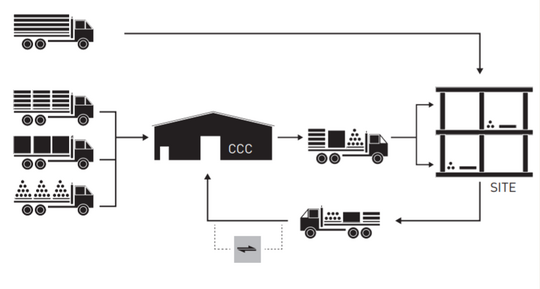Construction consolidation centre
(→Introduction to a construction consolidation centre (CCC)) |
(→Introduction to a construction consolidation centre (CCC)) |
||
| Line 22: | Line 22: | ||
[[File:Billede.png|thumb|left||upright=3.0|alt=A cartoon centipede reads books and types on a laptop.|Explainiation of CCC.]] | [[File:Billede.png|thumb|left||upright=3.0|alt=A cartoon centipede reads books and types on a laptop.|Explainiation of CCC.]] | ||
| − | + | *It is desirable to locates a CCC within a range of 30 minutes from many construction sites, however 45 minutes is the absolute maximum | |
| − | + | *A haulier should be able to make two to three deliveries from the CCC to the site within and eight-hour shift | |
| − | + | *A CCC should be close motorways or major roads, to reduce the impact on the traffic as much as possible | |
==References== | ==References== | ||
<references/> | <references/> | ||
Revision as of 16:42, 12 June 2017
Abstract
For large scale construction sites or construction sites in urban environments, a CCC is sometimes used to manage the logistics within material deliveries. A CCC is a place close to one or more construction sites, which facilitates the flow of materials going to the site through the supply chain. The CCC is comparable with a warehouse, since the construction materials are stored in the CCC until they are needed at the site. Another advantage of a CCC is the opportunity to reduce waste (or carbon emission from e.g. traffic) from the construction site and to recycle non-used materials. Despite the mentioned advantages of using a CCC, this is a relative new term, which almost only has been used in the United Kingdom. The question is, why is this not more commonly used worldwide? It is interesting to investigate and describe the term CCC and the advantages/disadvantages compared to e.g. the “deliver in time” method or other alternatives. It is essential to describe and discuss things like: The benefits of using a CCC, when is it the right choice, what is the optimal location and how is it implemented in a construction process? All this will be covered in a Wiki-article, which hopefully will be a short guidance to future project/construction managers, when the logistics of a construction site is considered, especially regarding where to use and not to use a CCC.
Introduction to a construction consolidation centre (CCC)
The basic idea
As mentioned, a CCC is a part of the supply chain for projects in urban environments. The idea is to reduce the number of vehicles delivering materials to the site. Deliveries may interact and interfere each other, if they are uncoordinated, which is often the case. A CCC is practically the same as a big warehouse. This warehouse facilitates one more construction sites at the time. Sometimes construction sites are congested, since the materials must be stored at the site, which could lead to material damage and waste. Material damage and waste are also one the main things to prevent using CCCs. At the same time, it possible to protect the materials better, when they are stored in a CCC, as it is easy the keep them save and dry (the materials are stored indoor in a CCC).
In a CCC the suppliers deliver a high amount of material or all the materials needed for the construction. Thereby, the site manager can order what is needed for the next part of the program face (also mentioned as just-in-time basis ), instead of having a high number of deliveries to the site, which possibly could disturb the construction workers, and keep them busy with other things than what they are supposed to (construct the building). Having a CCC deliveries to a site can be reduce drastically, since the daily deliveries depends on which face of the program the construction is in. However, large items though (e.g. a big steel girder or big concrete elements), must be delivered directly to the site. These items though, are often installed immediately at the site, and they are not in the way, for a long time.
Traffic and pollution
Another important reason for the development of CCCs is traffic. IN London for instance, the traffic is more and more affected by material deliveries. As mentioned, they are often uncoordinated, and they can have a huge effect on the traffic close to the site. When a CCC reduces the number of vehicles coming to the site, the problem about traffic should be solved, since fewer cars means less traffic. If the traffic is reduced the emission of C02 is also reduced, and at this is very important for the global environment. CO2 could also be reduced utilizing trucks with a low amount of carbon dioxide emission, to deliver the materials from the CCC to the site(s).
Location
The location of a CCC is of very high importance. The CCC cannot be located to far from the construction sites. Furthermore, it is considerably to consider which road the haulers should take to have less impact on the daily traffic. This is often done by placing a CCC close to big roads like motorways. Some good rules of thumb about the location of a CCC have been stated by Greger Lundesjo in the report “Using Construction Consolidation Centres to reduce construction waste and carbon emissions”[1].
- It is desirable to locates a CCC within a range of 30 minutes from many construction sites, however 45 minutes is the absolute maximum
- A haulier should be able to make two to three deliveries from the CCC to the site within and eight-hour shift
- A CCC should be close motorways or major roads, to reduce the impact on the traffic as much as possible
